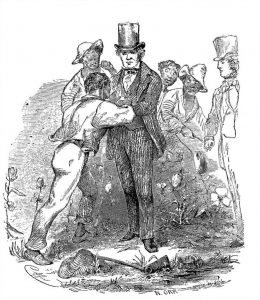 “How Twelve Years a Slave was Made, 150 years before 12 Years a Slave” was published in 2014 in the Los Angeles Review of Books. Looking at the literary history of the original publication of Solomon Northrup’s memoir, Prof. Kim explores the complicated politics of publishing a slavery narrative for a largely white audience.
“How Twelve Years a Slave was Made, 150 years before 12 Years a Slave” was published in 2014 in the Los Angeles Review of Books. Looking at the literary history of the original publication of Solomon Northrup’s memoir, Prof. Kim explores the complicated politics of publishing a slavery narrative for a largely white audience.
Tag: 19th century
In November 2012, I was part of a panel called Asian Americans in the South at SAMLA. I am presenting on lives of the Bunker twins, Chang and Eng, better known as the Siamese twins, who settled in North Carolina. More to the point, I will be presenting on the work I have done with my students on their archival materials at UNC and our collaboration with playwright Philip Kan Gotanda, who has written a new play about the twins.
I was happy to chair the Walt Whitman society panel at the American Literature Association in 2012, which featured three different but fascinating papers on Whitman’s careful print layout and typography choices, his reading of Dante and how that influenced his depiction of war as hell, and his influence on two modern ethnic writers and the discourse of gays in the military.
“The Francophone Uncle Tom’s Cabin” was published in the Little-Known Documents section of PMLA (Proceedings of the Modern Language Association) in May 2010 (125(3):798-815).
Charles Testut, a French-born Creole radical publisher and writer, wrote an epic novel detailing the adventures and eventual triumph of a married couple of Guadeloupean slaves illegally sold to the United States. It bears clear resemblances to Harriet Beecher Stowe’s Uncle Tom’s Cabin, but with Testut’s politics and his heavy French Romantic influence (by writers such as Alexandre Dumas), it is much more violent, sexual, and openly political a novel, with several diatribes against Catholic zealots, Louisiana judicial corruption, and racial prejudice. Though it was written before the Civil War, Testut was only able to publish the novel in 1872.
Article link here (requires subscription or pay per article). More information and an excerpt are available here.
My article “From Language to Empire: Walt Whitman in the Context of Popular Nineteenth-Century Anglo-Saxonism” was published in the Walt Whitman Quarterly Review in the Summer 2006 issue (24(1):1-19).
This article contextualizes Walt Whitman’s invocations of Anglo-Saxon culture and its uneasy connections to white supremacist writing by comparing his words to those of many popular magazines and newspapers dealing with the subject, from editorials in the most prominent newspapers to specialist magazine The Anglo-Saxon. The slippery slope from the cherishing of Anglo-Saxon words and literature to the racialist or imperialist ambitions of England and the United States can be traced in both Whitman and the other work, but Whitman’s emphasis on diversity and the freedom of the individual takes his Anglo-Saxonism in a new and unexpected direction.
Link to article here.